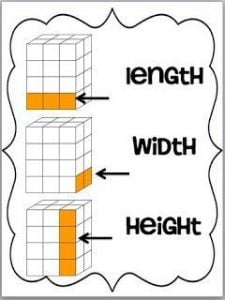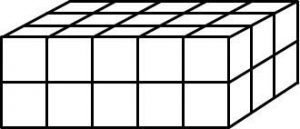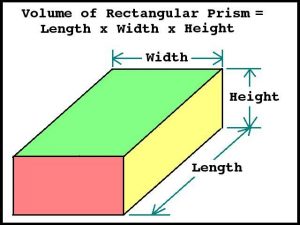by C. Elkins, OK Math and Reading Lady
I have worked with several groups of 4th graders lately to build rectangular prisms as a way of learning more about volume. Typically students know the formula (length x width x height), but often lack the strategies or spatial ability to solve problems seen only in picture (2D form). Concrete (hands-on) experiences help cement knowledge when abstract formulas may pose difficulty. And . . . it’s always fun to “play” while doing math!!
Here are some observations regarding students’ difficulties:
- Students often resort to counting the visible cubes, not realizing there are others on the back side – which can’t be seen on a 2D representation.
- Students are unsure which dimensions are the length, width, and height.
- Students lack multiplication skills.
- Students don’t know the purpose of finding volume (other than counting the cubes).
- Students are often confused when constructing prisms when one of the dimensions is 1. They weren’t sure this was even a possibility until they saw what it looked like (after building it!).
Some possible solutions:
Give students multiple opportunities to build 3D rectangular prisms:
- Length is the longest side on the base. Width is the shortest side on the base. The height is how tall it is.
- Use this variant of the L x W x H formula: (Area of the base) x Height or (L x W) x H. With this mindset, the students need to find the length and width dimensions first. Finding the area of the base first helps them visualize the bottom layer. Then the height just means the number of total stacks or layers (with all of them matching the area of the base).
- Give students specific dimensions such as (5 x 3) x 2.
- Using connecting cubes, build the base (bottom layer) first and determine the area (5 x 3 = 15).
- Then build 1 more layer just like it so there is a total of 2 layers (the height).
- Through this experience, students learn what a 5 by 3 base looks like . . . and that each layer of the height has the exact same area. It’s actually several layers stacked on top of each other.
- To complete this prism, compute the area of the base (5 x 3) and then multiply it by the height (2). So (5 x 3) x 2 = 30 cubic units.

- This experience shows why the measurement is stated as cubic units (because cubes were used).
- Students may also see another way to solve the problem is to add the area of the base 2 times (15 + 15). Of course, multiplication is more efficient, but seeing the addition solution helps them realize each layer is the same.
- Get this FREE Prism Building Activity and FREE Volume game for building rectangular prisms from me (click on links). For the game, you just need the recording sheet and 3 dice per pair of students.
- Don’t have connecting cubes? Check with KG or 1st grade classes!
Look for these free practical application activities from www.k-5mathteaching resources.com. Click on the word VOLUME and it will take you right to the page. These are free activities (with blue type).
- Building Rectangular Prisms:
 Use cubes to build a rectangular prism with a volume of 24 cubic cm or cubic inches. How many ways can you find to build this? To help children solve this I would first help them make a list of 2 factors that equal 24 (1 x 24, 2 x 12, 3 x 8, and 4 x 6). Then give them time to break these factors down again to show 3 factors that equal 24. Let students do the work, though!! This is just a picture of my solutions. Did I forget any?
Use cubes to build a rectangular prism with a volume of 24 cubic cm or cubic inches. How many ways can you find to build this? To help children solve this I would first help them make a list of 2 factors that equal 24 (1 x 24, 2 x 12, 3 x 8, and 4 x 6). Then give them time to break these factors down again to show 3 factors that equal 24. Let students do the work, though!! This is just a picture of my solutions. Did I forget any? - Exploring Volume: This activity provides rectangular prism nets to cut out, fold, tape together and add cubes.
- What’s the Volume?: Task cards are provided showing pictures of various rectangular prisms. The task is to select 4 of the cards, calculate the volume, and then arrange in order from least to greatest. I think making a prediction first would be interesting. Do students think taller is always more than shorter prisms?
- Design a Toy Box Using Volume: This is a real life problem to design a child’s toy box with a volume of 30 cubic feet. Like the building rectangular prism activity above, the students must first figure what 3 numbers multiply together to equal 30. But in this example, some of the results might make better dimensions for toys than others. Is a 1 foot x 2 foot by 15 foot toy box very practical?

Investigate ways volume is utilized in real life:
- In every classroom I visited, I conveniently found a Sterlite or Rubbermaid tub which still had its sticker which states the 3 dimensions for the volume (often in customary and metric). Maybe your class has one also.
- Brainstorm other types of containers: boxes, desk, file cabinet, crates, cardboard boxes, etc.
- List jobs in which the workers need to measure and work with volume: cabinet builders, house and building designers and builders, Amazon (for boxing items to be mailed), suitcase manufacturers, shoebox makers, etc.
Clip art provided by Microsoft Office Clip Art.